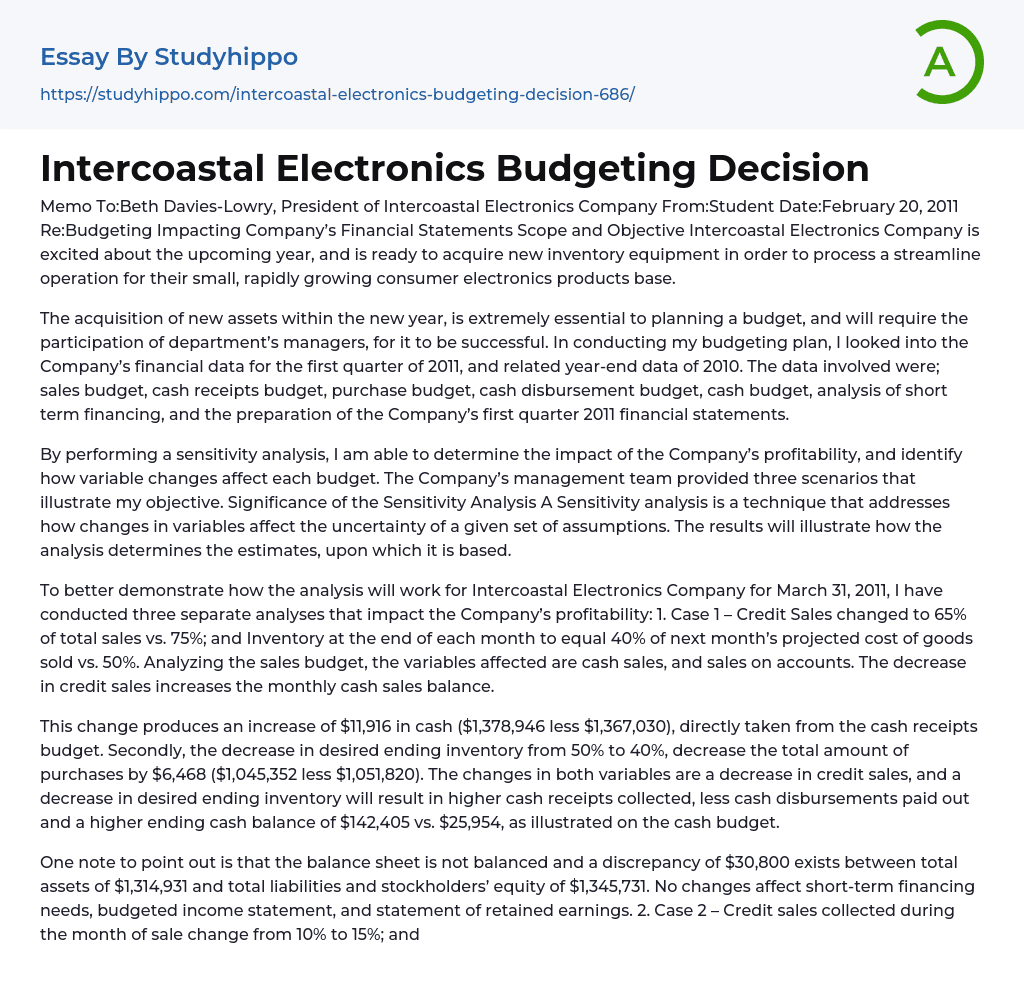
Intercoastal Electronics Company is excited about the upcoming year, and is ready to acquire new inventory equipment in order to process a streamline operation for their small, rapidly growing consumer electronics products base. The acquisition of new assets within the new year, is extremely essential to planning a budget, and will require the participation of department’s managers, for it to be successful.
In conducting my budgeting plan, I looked into the Company’s financial data for the first quarter of 2011, and related year-end data of 2010. The data involved were; sales budget, cash receipts budget, purchase budget, cash disbursement budget, cash budget, analysis of short term financing, and the preparation of the Company’s first quarter 2011 financial statements.
By performing a sensitivity analysis, I am able to determine the impact of the Company’s profitability, and identify how varia
...ble changes affect each budget. The Company’s management team provided three scenarios that illustrate my objective. Significance of the Sensitivity Analysis A Sensitivity analysis is a technique that addresses how changes in variables affect the uncertainty of a given set of assumptions. The results will illustrate how the analysis determines the estimates, upon which it is based.
To better demonstrate how the analysis will work for Intercoastal Electronics Company for March 31, 2011, I have conducted three separate analyses that impact the Company’s profitability:
Case 1 – Credit Sales changed to 65% of total sales vs. 75%; and Inventory at the end of each month to equal 40% of next month’s projected cost of goods sold vs. 50%. Analyzing the sales budget, the variables affected are cash sales, and sales on accounts. The decrease in credit sales increases the monthly cash sale
balance.
This change produces an increase of $11,916 in cash ($1,378,946 less $1,367,030), directly taken from the cash receipts budget. Secondly, the decrease in desired ending inventory from 50% to 40%, decrease the total amount of purchases by $6,468 ($1,045,352 less $1,051,820). The changes in both variables are a decrease in credit sales, and a decrease in desired ending inventory will result in higher cash receipts collected, less cash disbursements paid out and a higher ending cash balance of $142,405 vs. $25,954, as illustrated on the cash budget.
One note to point out is that the balance sheet is not balanced and a discrepancy of $30,800 exists between total assets of $1,314,931 and total liabilities and stockholders’ equity of $1,345,731. No changes affect short-term financing needs, budgeted income statement, and statement of retained earnings.
Case 2 – Credit sales collected during the month of sale change from 10% to 15%; and Monthly purchases paid during the month of purchase change from 40% to 50%. Analyzing the cash receipts budget, the variables affected are cash collections in the current month and the preceding months.
The change produces an increase of $4,965 in cash receipts ($1,371,995 less $1,367,030) directly taken from the cash receipts budget. Secondly, the increase in cash paid out on monthly purchases, increases the total amount of cash disbursements by $105,182 ($1,318,758 less $1,213,576), which results in ending cash balance shortage of $74,263. The changes in both variables will result on minor increases in cash receipts collected, and cash disbursements paid out, which would require the Company to acquire additional short term inancing, in order to conduct the Company’s operations.
Case 3 – Equipment Purchases required an $115,000 investment
vs. $125,000. Assuming that all other cost and revenues remain the same, by decreasing the purchase of the required investment by $10,000, the ending cash balance is increased $10,250, this represents the difference in investment cost and change in interest payment on the short term financing on the equipment, thus short term financing needs decreases from $100,000 to $90,000. The change required investment will result in slight increase in net income by $250 to $160,906, which is the difference in interest expenses.
Recommendations
In conclusion, the best case scenario for Intercostal Electronics Company is to adopt Case one. Case one provides the Company with more liquidity as it produces more cash than the other two cases. Furthermore, they will have enough cash on hand to purchase the equipment of $125,000, and will not require any short-term financing; thus avoiding any interest expense.
Case two on the other hand, will require the Company to obtain additional short-term financing to run their operations, as their cash disbursements exceed their cash collections in reviewing the equipment purchase. Case Three, enables the company to save $10,000 in short-term financing and $250 in interest expenses. The Company should maximize sales, aggressively collect cash receipts, and maintain cash disbursement within reasonable levels, in order to position themselves for future growth and investment opportunities.
- Budget essays
- Audit essays
- Budgeting essays
- Cost Accounting essays
- Accountability essays
- Accounting Software essays
- Accounts Receivable essays
- Auditor's Report essays
- Balance Sheet essays
- Cash essays
- Cash Flow essays
- Costs essays
- Financial Audit essays
- Internal Control essays
- International Financial Reporting Standards essays
- Management Accounting essays
- Principal essays
- Tax essays
- Accident essays
- Awareness essays
- Benefits of Volunteering essays
- Challenges essays
- Childhood Memories essays
- Decision essays
- Driving essays
- Event essays
- Excellence essays
- Expectations essays
- Failure essays
- Farewell essays
- Flight essays
- Gift essays
- Growing Up essays
- Ignorance essays
- Improve essays
- Incident essays
- Knowledge essays
- Luck essays
- Memories essays
- Mistake essays
- Obstacles essays
- Overcoming Challenges essays
- Party essays
- Peace Corps essays
- Personal Experience essays
- Problems essays
- Sacrifices essays
- Struggle essays
- Success essays
- Trust essays



